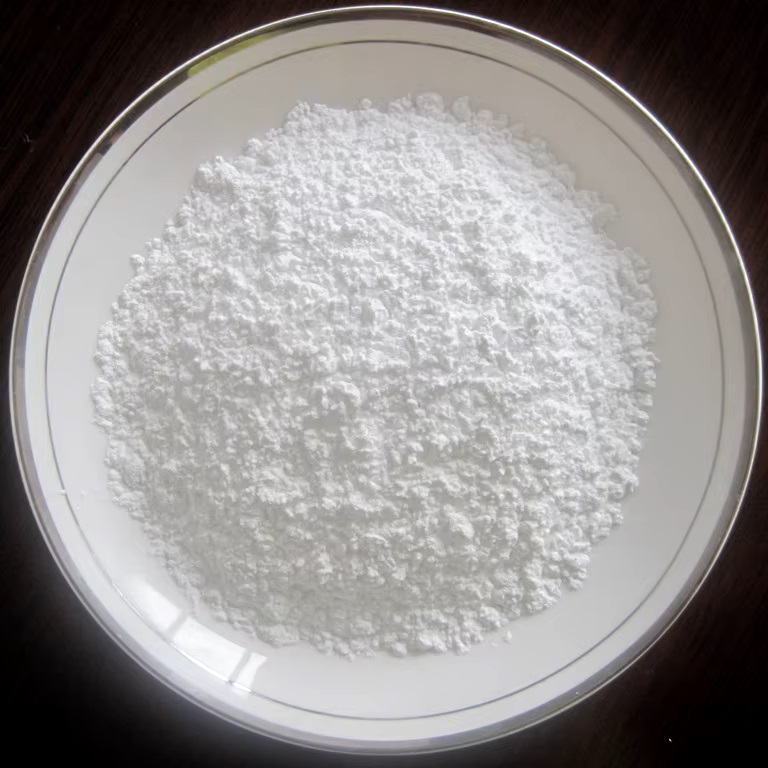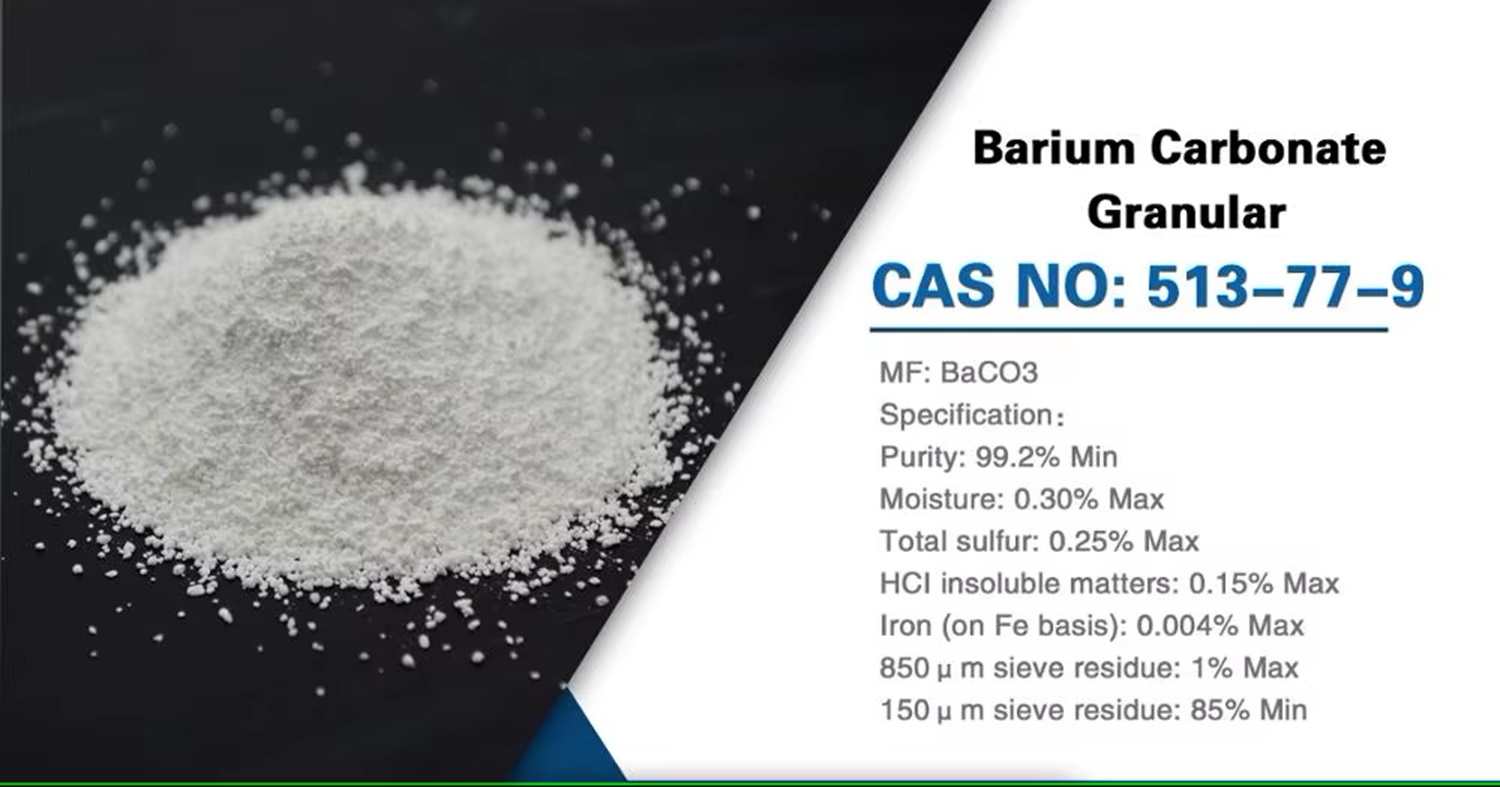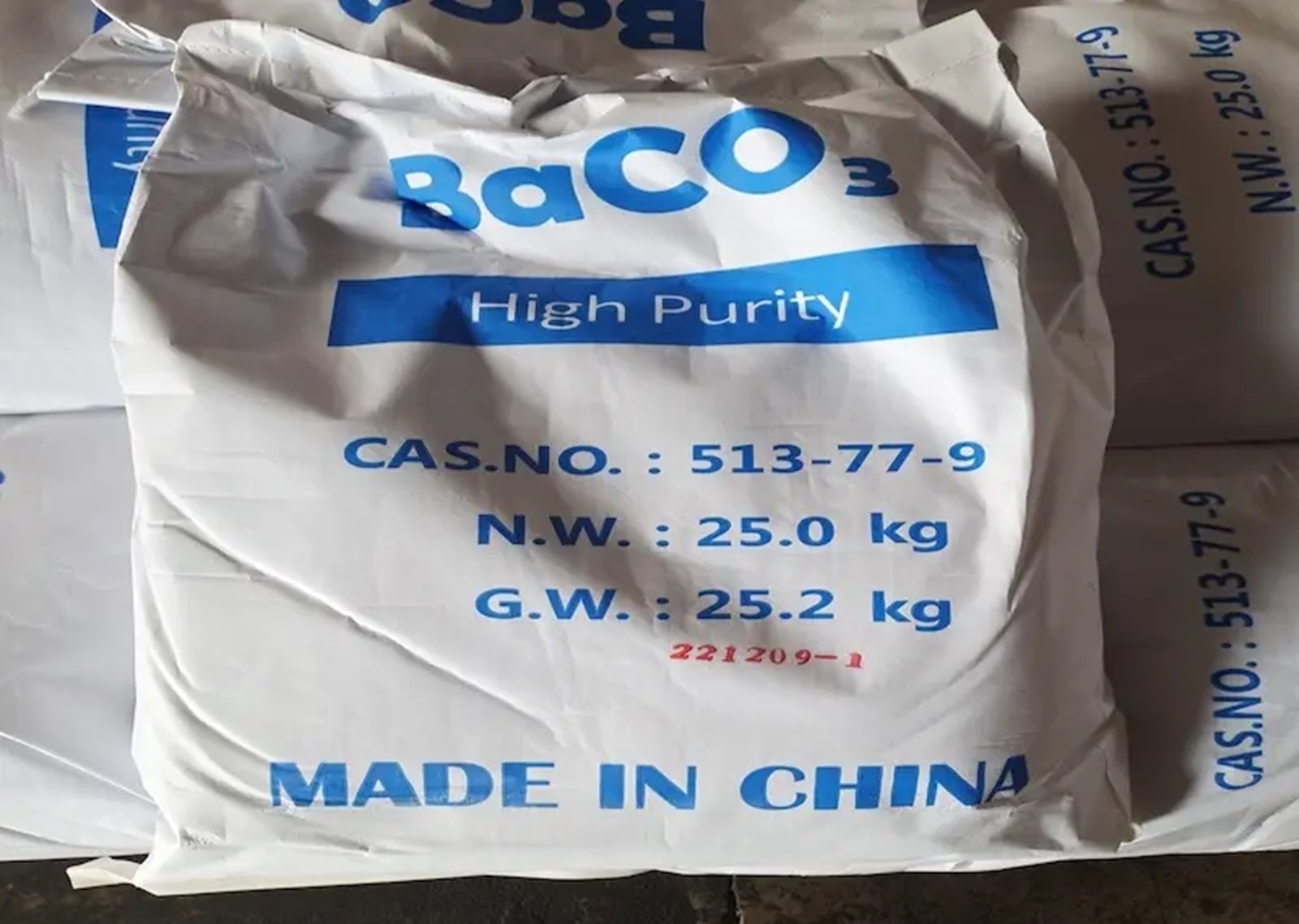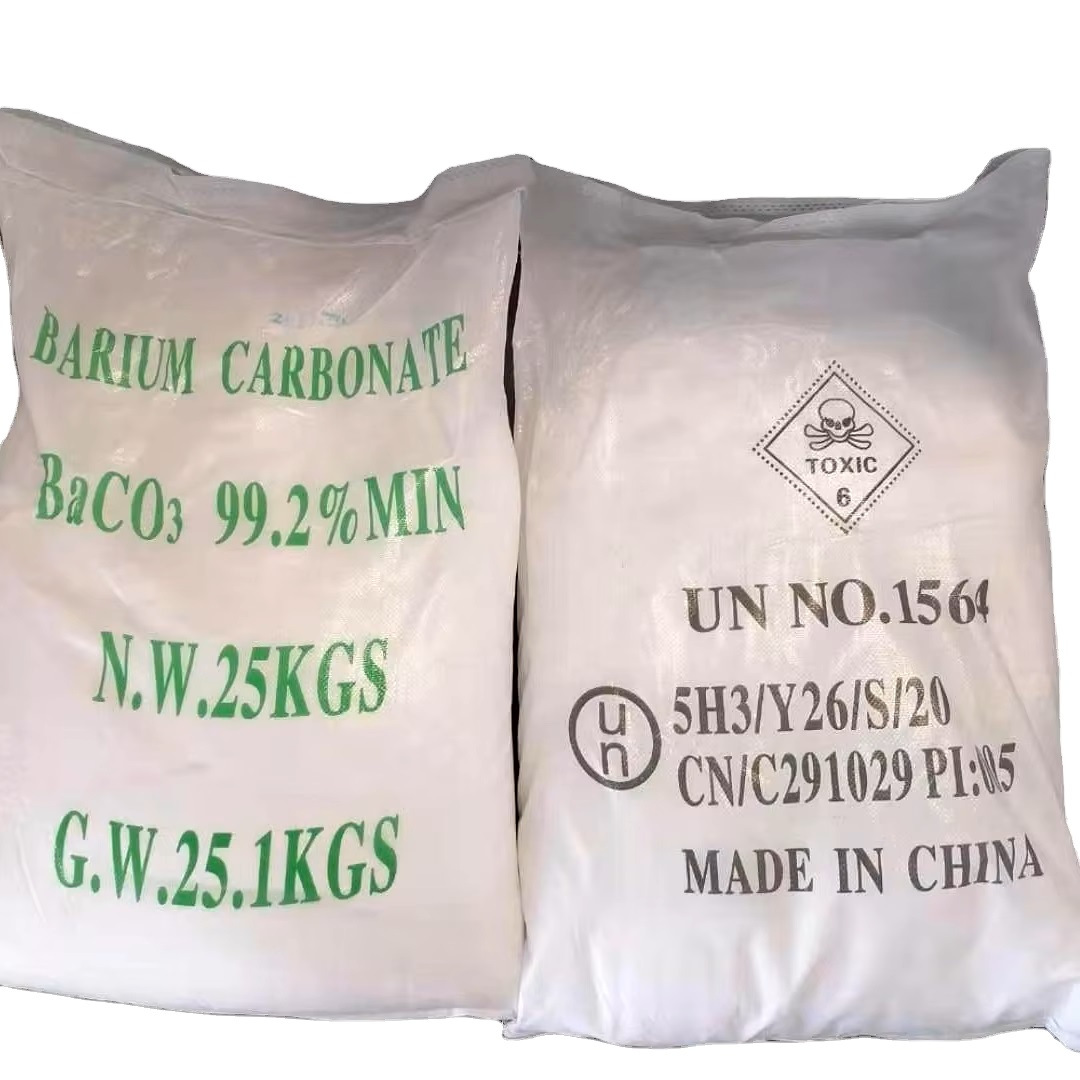We unleash your business potential by maximize the business innovation.
Send EmailBarium carbonate, Barium Mono Carbonate, Barium Carbonate Anhydrous, Witherite, 513-77-9
Barium carbonate is known by several other names, including:
-
Witherite (natural mineral form)
-
Barium monocarbonate
-
Carbonic acid, barium salt (1:1)
-
Barium salt of carbonic acid
CAS: 513-77-9
Molecular Formula: CBaO3
Names and Identifiers
| Name | Barium carbonate |
| Synonyms | bf1(salt) WITHERITE C.I. 77099 Barium carbonate BARIUM CARBONATE bariummonocarbonate C.I. Pigment White 10 bariumcarbonate(baco3) barium carbonate, natural CARBONIC ACID BARIUM SALT Barium Carbonate (Powder) Bariumcarbonate white powder Barium carbonate,high purity Barium Carbonate (Low Sulphur) Barium Carbonate (free flowing) BARIUM (II) CARBONATE (GAMMA-TYPE) barium carbonate, other than natural |
| CAS | 513-77-9 |
| EINECS | 208-167-3 |
| InChI | InChI=1/CH2O3.Ba.2H/c2-1(3)4;;;/h(H2,2,3,4);;;/p-2/rCH2O3.BaH2/c2-1(3)4;/h(H2,2,3,4);1H2/p-2 |
Physico-chemical Properties
| Molecular Formula | CBaO3 |
| Molar Mass | 197.34 |
| Density | 4.43 |
| Melting Point | 811 °C |
| Boling Point | 1450 °C |
| Water Solubility | 0.002 g/100 mL (20 ºC) |
| Solubility | 0.02g/l |
| Appearance | White powder |
| Specific Gravity | 4.43 |
| Color | White |
| Odor | Odorless |
| Solubility Product Constant(Ksp) | pKsp: 8.59 |
| Merck | 14,969 |
| BRN | 7045119 |
| PH | 7-8 (0.016g/l, H2O, 16℃) |
| Storage Condition | Store at +5°C to +30°C. |
| Stability | Stable. Incompatible with strong acids. |
| Sensitive | Easily absorbing moisture |
| MDL | MFCD00003448 |
| Physical and Chemical Properties | Industrial traits are white powder. melting point 1740 ℃ relative density 4.43 The solubility is almost insoluble in water, insoluble in alcohol, soluble in acid and ammonium chloride solution. There are three crystalline states of α, β and γ. Industrial products are white powder. The relative density was 4.43. The α-form has a melting point of 1740 °c (90.9 X 103Pa), the β-form is converted to the α-form at 928 °c and the γ-form is converted to the β-form at 811 °c. Almost insoluble in water, insoluble in alcohol, soluble in acid and ammonium chloride solution. Barium oxide and carbon dioxide are decomposed at 1450. When acid decomposition, and sulfuric acid to produce white barium sulfate precipitation. Slightly hygroscopic. Toxic. |
| Use | For the production of picture tube glass shell, electronic ceramics and purified water, the production of pigments, coatings or other barium salt Used for making optical glass, barium magnetic materials, etc It is an important chemical raw material for the production of picture tube glass shell, magnetic materials and advanced optical glass. For the preparation of fireworks, signal, also used for ceramic coatings and optical glass accessories Used in the manufacture of electronic ceramics, PTC thermistors, capacitors and other electronic components Mainly used in the manufacture of optical glass, picture tube glass and barium magnetic materials and capacitors, but also for steel carburizing and metal surface treatment. Is the manufacture of other barium salts and ceramics, enamel, pigments, coatings, rubber, electrode raw materials. It can also be used as water purification agent and rodenticide, oxidation reaction catalyst. Mainly used in the manufacture of optical glass, picture tube glass and barium magnetic |
Risk and Safety
| Hazard Symbols | Xn - Harmful |
| Risk Codes | 22 - Harmful if swallowed |
| Safety Description | 24/25 - Avoid contact with skin and eyes. |
| UN IDs | UN 1564 6.1/PG 3 |
| WGK Germany | - |
| RTECS | CQ8600000 |
| TSCA | Yes |
| HS Code | 28366000 |
| Hazard Class | 6.1(b) |
| Packing Group | III |
| Toxicity | LD50 orally in Rabbit: 418 mg/kg |
Upstream Downstream Industry
| Raw Materials | Sodium carbonate Carbon Dioxide Calcium carbonate Barium sulfate |
| Downstream Products | Barium nitrate Barium chloride Sodium Tripolyphosphate Barium fluoride Barium nitrate Barium chloride |
Nature
hexagonal crystal or white powder. Melting Point 1740 °c (decomposition). Soluble in acid, ammonium chloride or ammonium nitrate solution to generate the net; Slightly soluble in carbon dioxide containing water; Insoluble in water. Toxic!
Preparation Method
- The main method for industrial production of high purity barium carbonate is to use soluble barium salt (such as barium chloride) and carbonate reaction, after purification treatment.
- carbonization method in barium sulfide solution (see barium sulfide for preparation), carbon dioxide gas is introduced for carbonization to obtain barium carbonate slurry, which is desulfurized, washed, vacuum filtered, dried at 300 ℃, and pulverized, finished barium carbonate was obtained.
- The double decomposition method is a double decomposition reaction between barium sulfide and ammonium carbonate, followed by washing, filtration, drying, etc., to obtain a barium carbonate product.
Introduction
Toxic. Soluble in dilute hydrochloric acid, dilute nitric acid, acetic acid, ammonium chloride solution and ammonium sulfate solution, slightly soluble in water containing carbon dioxide, insoluble in water. It decomposes into barium oxide and carbon dioxide at about 1300 ℃. Relative density 4.43. Low toxicity, half lethal dose (rat, oral) 800mg/kg.
Use
- used in the production of PTC thermal electronic components, chip-based components, semiconductor capacitors, etc.
- It is used for manufacturing optical glass, picture tube glass, barium magnetic materials and capacitors, etc., and is also used for steel carburizing and metal surface treatment. Is the manufacture of other barium salts and ceramics, enamel, pigments, coatings, rubber, electrode raw materials. It can also be used as a water purifying agent and a rodenticide.
Safety
- packaging method: Plastic bag outer composite plastic woven bag.
- Health hazard: after oral administration, it reacts with gastric acid and becomes barium chloride to cause poisoning. Acute poisoning showed Nausea, Vomit, Abdominal Pain, Diarrhea, slow pulse, progressive muscle paralysis, heart rhythm disorders, serum potassium decreased significantly. Death can result from heart rhythm disturbances and paralysis of the respiratory muscles. Severe acute renal failure, hypoxic encephalopathy, acidosis, etc.
- first aid measures: drink enough warm water to induce vomiting. Gastric lavage with 2% ~ 5% sodium sulfate solution, catharsis. The patient visited hospital.
- precautions for storage: Store in a cool and ventilated warehouse. Keep away from fire and heat source. The packaging is sealed. Should be stored separately from acids, edible chemicals. Avoid mixed storage.
- Protection Measure: workers should wear dust masks, glasses, gloves and protective clothing.
- Transportation Information: Dangerous Goods number: 61021, classification and marking of commonly used Hazardous Chemicals (GB 13690-92) classify the substance as category 6.1 toxic substances.
Reference Information
| Decomposition | 1300°C |
| manufacturing piezoelectric ceramic capacitors | barium carbonate is widely used in the manufacture of piezoelectric ceramic capacitors such as high voltage AC capacitors and ultrasonic transducer devices. the piezoelectric effect was first discovered by Curie brothers on a quartz crystal in 1880. the crystal that can produce piezoelectric effect is called piezoelectric crystal. A type of piezoelectric crystal is single crystal, such as Shi Ying (SiO2), potassium sodium tartrate (also known as Loser salt, NaKC4H4O6 * H2O), bismuth germanate (Bi12GeO20), etc. Another type of piezoelectric crystal is called piezoelectric ceramic, such as barium titanate (BaTiO3), lead zirconate titanate [Pb(ZrxTirx)O3, code PZT], lead niobium magnesium zirconate titanate made in Japan [Pb(Mg1/3 Nb2/3)O3 added PZT, replace PCM], lead antimony manganese zirconium titanate [Pb(Mn1/2 Sb2/3)O3 added to PIT code PMS] made in China, etc. there are three main types of manufacturing materials for piezoelectric ceramics: lead zirconate titanate raw materials (PbZrTiO3): titanium dioxide, zirconia, lead oxide, strontium carbonate, niobium oxide, lanthanum oxide, etc. lead magnesium niobate raw materials (PbNbMgO3): niobium oxide, magnesium oxide, lead oxide, strontium carbonate, lanthanum oxide, etc. Barium titanate raw materials (BaTiO3): titanium dioxide, barium carbonate, strontium carbonate, etc. |
| solubility in water (g/100ml) | dissolved grams per 100ml of water: 1.409 × 10-3/20 ℃ |
| Toxicity | This product is a drug. Chronic poisoning mainly accumulates on bones, causing proliferation of bone marrow leukocyte tissue. In severe acute poisoning, acute gastrointestinal diseases occur, tendon reflexes disappear, spasm, muscle paralysis. Emergency treatment to take gastric lavage, enema, taking emetic and other measures. The maximum allowable concentration is 0.5 mg/m3. Work clothes, masks and gloves should be worn during production. See barium carbonate. |
| use | mainly used to manufacture optical glass, picture tube glass shell and barium magnetic material, is the raw material for manufacturing other barium salts, ceramics, enamel, pigments, welding rods is the production of picture tube glass shell, magnetic materials and advanced optical glass important chemical raw materials. It is used for the preparation of fireworks and signal flares, as well as auxiliary materials for ceramic coatings and optical glass It is used for the manufacture of electronic ceramics, PTC thermistors, capacitors and other electronic components It is mainly used for the manufacture of optical glass, picture tube glass, barium magnetic materials and capacitors, etc. It is also used for steel carburizing and metal surface treatment. It is the raw material for manufacturing other barium salts and ceramics, enamel, pigments, coatings, rubber, and welding rods. It can also be used as a water purifier, rodenticide and oxidation reaction catalyst. It is mainly used to manufacture optical glass, picture tube glass, barium magnetic materials and capacitors, etc. It is also used for steel carburizing and metal surface treatment. It is the raw material for manufacturing other lock salts and ceramics, enamel, pigments, coatings, rubber, and welding rods. It can also be used as a water purifier and rodenticide. It is used to produce kinescope glass shells, electronic ceramics and purified water, and to produce pigments, coatings or other barium salts for making optical glass, barium magnetic materials, etc. It is an important chemical raw material for producing kinescope glass shells, magnetic materials and advanced optical glass. It is used for the preparation of fireworks and signal bombs, as well as auxiliary materials for ceramic coatings and optical glass. It is used for the manufacture of electronic ceramics, PTC thermistors, capacitors and other electronic components. It is mainly used for the manufacture of optical glass, picture tube glass, barium magnetic materials and capacitors, etc. It is also used for steel carburizing and metal surface treatment. It is the raw material for manufacturing other barium salts and ceramics, enamel, pigments, coatings, rubber, and welding rods. It can also be used as a water purifier, rodenticide and oxidation reaction catalyst. Mainly used to make optical glass, picture tube glass and barium magnetic |
| production method | carbonization method carbonizes barium carbonate with carbon dioxide gas in barium sulfide solution (see barium sulfide for preparation) to obtain barium carbonate slurry, which is desulfurized and washed, vacuum filtered, dried and crushed at 300 ℃ to obtain barium carbonate finished product. Its BaS + CO2 + H2O → BaCO3 ↓ + H2S ↑ metathesis method is carried out by barium sulfide and ammonium carbonate for metathesis reaction, and then washed, filtered and dried to obtain bismuth carbonate finished product. Its BaS +(NH4)2CO3 → BaCO3 ↓ +(NH4)2S toxic nepheline conversion method reacts toxic heavy stone ore powder with ammonium salt to generate soluble barium salt. At the same time, ammonium carbonate is recycled for use, soluble barium salt is added to ammonium carbonate to precipitate refined barium carbonate, which is filtered and dried to produce barium carbonate finished product. The mother liquor obtained is recycled and recycled. carbonization method. Reaction equation: BaS + CO2 → BaCO3 ↓ + H2S ↑ Operation method: 1L aqueous solution containing 180g/L barium sulfide is reacted with carbon dioxide at 70 ℃ to generate precipitated barium carbonate. The precipitation was mixed with 10ml of 25% ammonia water and desulfurized at 60 ℃ for 20min. After filtration and drying, precipitated barium carbonate is obtained, and the product contains 0.46% sulfur. metathesis method. Reaction equation: BaCl2 + NH4HCO3 + NH4OH → BaCO3 ↓ + 2NH4Cl + H2O operation method: 23.6L aqueous solution containing 56.1g/L ammonium bicarbonate and 1.36L ammonia water are mixed in a 50L kettle at 30 ℃, then 21.6L 200.3g/L barium chloride solution is added dropwise at 50 ℃ for 2h, and stirred at 40 ℃ for 30min. Filtration, drying at 140 ℃, crushing, the average particle size d of barium carbonate is 0.8 μm, and the purity is 99.8%. Tampite method. Reaction equation: BaCO3 + 2NH4Cl → BaCl2 +2NH3 + H2O + CO2 BaCL2 +(NH4)2CO3 → BaCO3 ↓ + 2NH4Cl Operation method: 100 g of 80% arsenite powder (120 mesh) is mixed with 60g of ammonium chloride, and quickly put into a muffle furnace at 650 ℃ for 3min. After cooling, water immersion, filtration, slag removal, barium chloride solution is obtained, 36g ammonium carbonate is added to precipitate barium carbonate, filtration, drying and crushing, and the conversion rate is 91%. dry granulation will be heavy precipitated barium carbonate sieve, placed in the raw material bin fully stirring, mixing, degassing, material through the rotary feeder, horizontal vertical screw conveyor input roller press production, production thickness of 3.7~4mm. The material rolled into pieces is input into the granulator, and the particle size distribution of the semi-finished product is adjusted by adjusting its speed and the size of the sieve plate opening. Semi-finished products are fed into the vibrating screen by scraper pulse pneumatic conveying method. Particles above 20 mesh are returned to the granulator, particles below 65 mesh are returned to the raw material bin, and particles between 65 mesh and 20 mesh are transported to the finished product packaging bin for packaging to produce granular barium carbonate. In the process of wet granulation of barium carbonate production, the water content of the filter cake separated by the sedimentation system is controlled to be about 20%. Under the action of rotating blades, the materials are quickly mixed and evenly, and are mixed and kneaded to form dense particles. The wet particles are put into a direct fire rotary kiln and sintered at 800~1200 ℃. After the whole grain, screening, iron removal, metering packaging, the preparation of granular barium carbonate. |
| category | pesticide |
| toxicity classification | highly toxic |
| acute toxicity | oral-rat LD50: 418 mg/kg; Oral-mouse LD50: 200 mg/kg |
| flammability hazard characteristics | toxic barium oxide smoke is produced when heated; food: gastric ulcer, muscle weakness, paresthesia, paralysis, diarrhea, vomiting |
| storage and transportation characteristics | warehouse ventilation and low temperature drying; Store separately from acids and food additives |
| fire extinguishing agent | water, carbon dioxide, dry powder, sand |
| occupational standard | TWA 0.5 mg (barium)/m3; STEL 1.5 mg (barium)/m3 |




